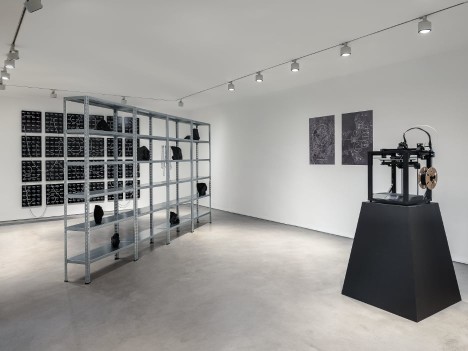Review
Nolan Oswald Dennis: throwers
Amrita Dhallu finds the South African artist’s imaginative history of stone throwing has become a foundation for worldmaking

Nolan Oswald Dennis, ‘throwers’, installation view
The whirr of a 3D printer welcomes me as I enter ‘throwers’. The machine exudes gravitas. Mounted on a hefty trapezoidal monolith, isivivane, 2023–, is positioned at the heart of the installation. A set of posters charting rock formations overlaid with microscopic geological textures sits opposite a trio of sterile, galvanised steel shelves that display freshly 3D-printed rock specimens. A sparseness defines this first installation: a pair of posters are the only images on a long white wall, the shelves are relatively empty. The blankness is suggestive of a space awaiting completion, or that we are witness to some unfinished process.
Nolan Oswald Dennis is a Johannesburg-based multidisciplinary artist who has cultivated a systemsbased approach to exploring the intersection of art, science and the history of African liberation and resistance. Their work queries ‘fixed’ knowledge systems and the conditions in which they are exchanged and canonised. The exhibition’s title directly references Dennis’s plotting of a ‘social history of “stones-that-move”’ – further elucidated in their 2025 Serpentine essay, ‘Throwers (space-rock notes pt.1)’. The exhibition’s theoretical underpinning is an exploration of the systemic interruptions caused by the ‘stone thrower’, interruptions that are further elaborated by Dennis’s image-based archive (photographs, drawings, charts) of citizens and mythological figures who have thrown rocks. These archived elements are presented alongside 3D-printed rock samples that have been copied from numerous settler colonial contexts, including Australia and South Africa. ‘throwers’ outlines the possibilities made from the collision of historic, geographic, intergalactic and metaphysical worlds that rocks hold.
A key element of Dennis’s geo-poetic practice is linguistic. The artist often coins their own terms to suitably frame their multidimensional investigations, as explored in the wall-based work further notes 4 a planet (24-dash), 2025, comprising a monochromatic grid of 24 panels on which Dennis has printed a series of ‘world-words’: different invocations of what our world(s) are and can be. There are around 480 phrases to absorb, but my eye hovers on those that invoke a destructive unravelling: ‘WOUNDED WORLD(S)’, ‘TRUSTLESS WORLD(S)’, ‘FUTILE WORLD(S)’. Pinned across the panels are beaded sentences lifted from the work of South African poet Keorapetse Kgositsile. Phrases such as ‘you are the dance and the dancer […] the concrete foundation and the builder’ swoop across the work. There is the potential to unhook the end of any beaded sentence and reposition or replace it altogether, as suggested by the dormant chains hung beside the grid. The beads themselves reiterate the collapsible and ever-changing potential of language as a system – any movement could spark a chain reaction in meaning-making.
This fragility is similarly explored in the diagrammatic work recurse 4 a late planet (lush), 2024–. An overwhelming yet energetic floor-to-ceiling rendering, this work displays various journeys that asteroids embark on as they encroach on Earth’s orbit. Bewildering lines, flying arrows and multidirectional graphs chart the trajectories, velocities and paths of various space rocks. Stopping myself from attempting to read the work in a singular, linear manner, my vision begins to ricochet across the wall, tracing the visual and rhythmic elements rather than attempting to read the text: upturned world maps, outlines of figures throwing stones, darting lines emerging from their hands. Tiny talismans puncture an overbearing scientific visual lexicon as they mark a spiritual and ritualistic embodiment of time and space. The piercing of a dominating structure reveals how orbiting rocks cause rupture. Each time a person made the radical decision to pick up and throw a stone, the work suggests, the course of linear time has dramatically and often irreversibly changed.
The persistent hum of the printer pulls me back into isivivane – it becomes the exhibition’s background hum, gently emphasising the continual process of making and unmaking worlds. What does it mean for the work to expedite geologic time? What does it mean to bear witness to the extraction, transportation and transformation of geological matter? While their plastic materiality implies a prop-like nature, Dennis insists on their aliveness. In isiZulu, the installation’s title loosely translates as ‘working together as a community’. The whir of the machine becomes part of the installation’s voice, while each woven thread constitutes a single contour of the land from which they were seized. In a 2022 interview with writer Zoé Samudzi, Dennis expressed the ‘demand to think of the land as something we do (a collective happening) – a process, procedure, and practice rather than a thing’. ‘throwers’ puts forward a series of tangible worldmaking methods that tussle with pre-existing structures. The shelving units, the globes, the grid, the map – all of these colonial instruments through which to interpret and contain the world are collapsing, unable to hold Dennis’s provocations for new planetary sensibilities.
Nolan Oswald Dennis, ‘throwers’, Gasworks, London, 24 April to 22 June 2025
Amrita Dhallu is a curator based in East Sussex.
First published in Art Monthly 487: June 2025.









